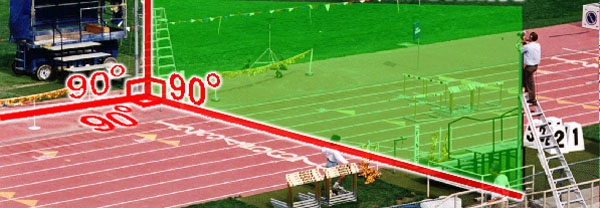EtherLynx Camera Mounting
EtherLynx cameras should be securely mounted to a permanent or temporary structure and positioned in the plane of the finish line. The height and distance from the finish line depends on the sport and lens used.
This positioning is not essential for proper functioning of the system. It simply reduces the likelihood of one athlete "blocking out” someone who is on the outside of them from the point of view of the camera. Large venues will likely have to place the camera further back from the finish line.
|
NOTE: Lower heights are acceptable, and often useful on the inside of a two camera system, since most people finish on the inside lanes and these individuals (and their hip numbers) will consequently be much larger in the image.
|
An important fact about EtherLynx cameras is that they see a very narrow slice of the world. The challenge for the FinishLynx operator is to make sure that the slice of the world that the camera sees is the right one - the finish line.
This is an imaginary line which continues the finish line beyond the boundaries of the track. A correctly aligned camera MUST be positioned somewhere along this line. You can either extend the finish line visually by sighting along the finish line, or you can establish its position by means of a string stretched along the finish line and extending beyond the track to the camera.
As mentioned above, a correctly aligned camera MUST be on this line, but, unfortunately, it is perfectly possible to have an incorrectly aligned camera on the line - as you will see.
Once the plane of the finish line has been established, the camera and mounting hardware can be placed in position. The camera can be placed just about anywhere along this line.
Pole
If a permanent pole is installed, great care should be taken to ensure that it is in the correct position. In general, pole-mounted cameras give better quality pictures because there is less chance of one competitor “blocking” the camera’s view of another competitor.
Tripod
The tripod should, of course, be level. This not only makes for the most accurate times, but it makes the process of alignment simpler. The center axis of the tripod should be in the extended plane of the finish line. The tripod should be as fully extended as it is going to be before actually taking any live image shots. Do not assume that the camera will stay aligned if the head tube of the tripod is extended.
Clamp
If a clamp is used, it should be securely fastened to an object that will not be subject to vibration or movement.
- Set up the camera on the tripod or camera-pole in the APPROXIMATE position.
- Connect a long length of twine to the camera securing screw (under the camera) and take the other end to the MIDDLE OF THE FINISH LINE ON THE FAR SIDE of the track (Position B as indicated in Camera Positioning). Have a volunteer hold the string taut. This is the SIGHT LINE.
- On the NEAR SIDE of the track have a volunteer hold the plumb bob so that it is suspended DIRECTLY ABOVE THE MIDDLE OF THE FINISH LINE (Position A as indicated in Camera Positioning). This is the PLUMB LINE.
- Keeping the SIGHT LINE taut, carefully move the tripod/pole either to the left or to the right until the PLUMB LINE and SIGHT LINE touch at position C.
The camera is now in the PLANE OF THE FINISH LINE.
If the camera is level and pointing directly across the track (you may need to carefully pan the camera from side to side) you will be correctly aligned.
Distant Mounting
The camera can be successfully mounted at a very great distance from the finish line (a couple hundred feet is not unheard of). However, there are a few things to keep in mind in this situation:
- The finish line seems to get narrower, and thus harder to find, the further away from it the camera is. Very little angular movement in the tripod head can translate into an enormous physical distance on the track.
- As a side effect of the point above, an extremely solid mounting should be used on windy days. Also, no one should be allowed near the area where the camera is mounted, as the vibrations of someone climbing a scaffold, for example, can put the camera in and out of alignment. This will appear as alternating black and white stripes on the image.


